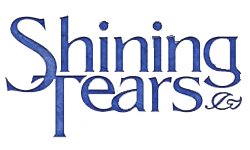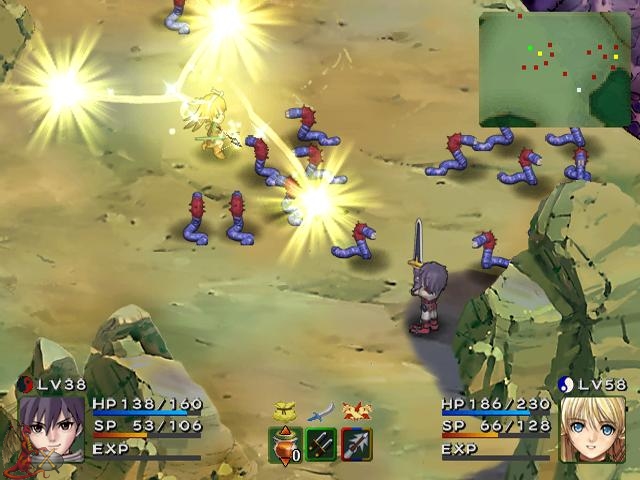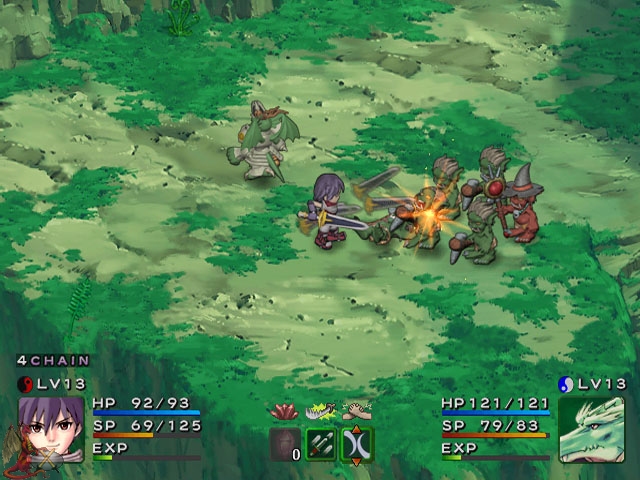|
|

|
BATTLE SYSTEM
|

|
INTERACTION
|

|
ORIGINALITY
|

|
STORY
|

|
MUSIC & SOUND
|

|
VISUALS
|

|
CHALLENGE
|
Medium
|
COMPLETION TIME
|
25-45 hours
|
|
OVERALL
3/5
|
Rating definitions
|
|
|
This review was written with the basis of the game being played with two players. Thus, it is quite a different perspective than if the game were to be played with solely one player. To view the differences between the two modes, please also reference the single player review, written by Derek Cavin.
The Shining series, more well known for its tactical Shining Force entries, did go back to its original roots as an action-RPG with the releases of Shining Soul and Shining Soul II. While these games touted multiplayer capabilities, the system used was not quite refined and thus the game's single player mode was its primary use. However, with Shining Tears, multiplayer becomes a viable option. Though the game has a huge amount of potential, for every positive it has in its battle system, interface, characters, and storyline, each is offset by a negative that cannot be overlooked.
The concepts of Yin and Yang (often referred to as good and evil, or light and dark) play a heavy role in Shining Tears' battle system. The game will build up to 8 selectable partners for Xion, each with their own specialty. Some are physical characters, meant to take out large groups of enemies, while others are built for ranged attacks, magic, and curing. However, no two characters' abilities completely overlap, so choosing who to bring to a level can sometimes be guesswork. Mostly, it will depend upon the players to choose their character based on a preferred strategy. Each character, with the exception of Xion, is aligned either Yin or Yang (there are 4 of each); Xion will be the opposite alignment of whoever is chosen. Some characters will change alignment as time passes in the game, and their abilities modify slightly because of it. Xion's abilities change depending which alignment he is; during Yin, Xion has a lightning attack and has a slightly higher magic stat, while during Yang the lightning attack is swapped for one that pushes the enemy back, as well as a higher attack stat. If the player chooses they may take a trip to a "mirrored" world to gain additional levels; this allows characters other than Xion to be chosen and levelled up. A second mirrored world is also accessible providing that two different save files from two different memory cards are available.
 Links Skills Very Important
Links Skills Very Important
|
|
When a character attains a new level, they are awarded 3 stat points and 1 skill point. Stats are STR, AGI, INT, and CON. Strength affects attack, agility affects accuracy and evasion, intelligence affects SP levels and magic, while constitution affects HP. Skills are what makes each character special. Each have a Locked Skill, which is an ability that cannot be leveled but leads into other abilities. Single Skills are charged up then unleashed onto the enemy, using SP. Link Skill are performed while the partner is Locked (Xion has no discernable link skills, it is always his partner that uses them); each character has several unique ones as well as a Guardian summon with varying effects (such as damage plus paralyzation). Finally, each character has auto skills, some of which are useful, most of which are not. All of this is controlled by the first player. Choice of skills, characters, etc, are done with the first controller only. Also controlled by the first player is the town menu. This consists of status (where the points at level are divided), map move to bring Xion to different areas of town, save, and equipping. There is also equipment specific to one or two characters to consider. Helmets require specific STR and INT, while Armor requires AGI and CON. Accessories can be equipped providing the character meets the level requirement, and bestow a variety of abilities and stat increases. Lastly, each character has a weapon which must be forged to increase its power. There are four tiers - or levels - of weapons, each with a number of weapon varieties per tier. To obtain more powerful weapons, the right ingredients (picked up randomly in chests or dropped by enemies) must be applied while the characters are at the right levels. All in all, there are a significantly large number of restrictions as to what the character is capable of equipping, and this process of discovering who needs what and where can become somewhat aggravating by the end of the game.
In battle is where the second player really comes to their glory. Each player attacks with the circle button; Xion has 3-hit combos while every other player has a 2-hit combo. The triangle button chooses an item class, while the up and down on the d-pad chooses within that class. The square button uses that item. Left and right on the d-pad moves to a listing of single skills as well as link skills, while up and down again moves between them. Holding down the circle button charges up single skills, which can be charged up multiple levels as skill points are attributed to them. When the second player hits L1, it activates their Locked Skill, and the first player may hit L1 to begin the Link Skill. While all this sounds complicated, the game forces the player to fight the first six battles with each of the first six characters without a second player's help, thus feeding everyone that plays a basic tutorial. Mostly the battle system consists of mashing or holding the circle button and remembering to heal (HP/SP as well as status effects) before death. The problem with the battle system is not its concept but its execution. The computer AI is simply stupid. Enemies generally rush the characters, only to stand around idle; or, they move in to attack and then run away, making defeating them tedious. Enemies, including boss monsters, often have the habit of running into walls and trying to keep running; even more annoying is the fact that enemies can push Xion and his allies around, making Link Skills more difficult to use accurately. Additionally, the game seeks to add difficulty by throwing a huge amount of enemies at the players, especially during later dungeons. This means that throughout the game there is considerable lag while the PS2 attempts to keep up with the huge amount of activity going on during large scale battles. Using specific Guardian Summons, which affect large areas, creates a 'now loading' screen that takes three to six seconds to clear and have the battle reloaded. These are all large flaws in the game mechanics and cause plenty of frustration.
The game runs in an isometric - not quite overhead - view. The characters are sprites with oddly large heads, set onto anime-style backgrounds. This gives the game a very upbeat and bright look, which is nice to see but is a bit conflicting with the game's course, considering the story is about the potential destruction of the world as the characters know it. Each character also has a full body art used for conversation scenes (this art vibrates to show strong emotions, which looks silly) and in the menus, as well as head shots used in various selection menus. The music is good, and fits the overall atmosphere, but does not especially stand out as something to listen to outside of the actual gameplay. Overall the graphics and music do their job and not much more, making them very middle-line average.
 Thousand Thrust Skill
Thousand Thrust Skill
|
|
The difficulty of Shining Tears will depend upon those playing it. Choosing characters that work well together and fit the players' styles means a playthrough of the game could take as little as 20 hours; exploring the optional dungeons can extend the game to 40 hours. When the game is defeated for the first time, a second mode, considered advanced, is unlocked. So, when a second playthrough is begun the players have the choice of carrying over their data into a new Normal or a new Advanced difficulty of the game. In Advanced mode, skills have a maximum level of 20 instead of the original 10, and the enemies have a much higher difficulty. Adding this second playthrough into the equation, subsequent runs of the game will take 25 or greater hours due to the increased difficulty in enemies. While playing alone may be difficult, choosing a partner wisely will make the game much more enjoyable and the time seems to fly in two player mode.
The translation of Shining Tears is mostly well done. There are noticeable errors, consisting of instances of unspaced words, missing periods at the end of sentences, and other small flubs. While these do not interfere with the gameplay itself, they are an odd occurence, considering that few games nowadays have these errors. While there is voice acting, these sound clips are few, but unfortunately incredibly overused. As an example, Ryuna casts a spell which damages the undead without the possibility of the undead enemies reviving themselves, instead of having to defeat them multiple times. Each time the spell is cast, a voice bit activates. Since there are several levels full of undead, it's not uncommon to use this spell a dozen times or more, making the voice acting become very tedious very quickly. The menus are well done, mostly consisting of graphics and small explanations as to what item does which. Though only the first player can control the general menu, while in battle, each player can draw up a menu, or keep items in a shortcut bar near the bottom of the screen. The system is simple but effective and all that's needed in an action-based RPG like this one.
The Yin and Yang aspect is also found in the originality, as well as the story. It seems almost symbolic that for every good aspect the game has, it also has something done wrong. The story is unique within the Shining universe, although like most recent Shining games hearkens back to its Shining Force popularity by including races (Volg is similar to the original werebeast, Zylo), enemies (the dreaded Laser Eye comes back in gigantic swarms), as well as ideals (the Shining Force plays a part in the latter half of the game), so those RPGamers who immerse themselves in all things Shining will enjoy. Even those who have never played a Shining series game needn't worry, however. The story stands on its own as a single entity, despite the repeated nods to previous games, and makes an excellent introduction to those that aren't familiar with the Shining games of past consoles.
Shining Tears had a huge amount of potential. As one of the rare multiplayer RPGs, it could have been a successor to Secret of Mana, but while it certainly has redeeming qualities, these fail to counterbalance the mistakes made in the game. Those looking for a multiplayer game will likely get a decent amount of use out of it, simply because there is little else like it. Those who prefer solo play are more apt to find a game they enjoy elsewhere, as the game is far more frustrating when played without a human partner. With Shining Tears being the third Shining-based Action RPG within a few years, it is entirely possible to see another game like it. Hopefully any future incarnations will learn from the mistakes made here and become a title worthy of the Shining moniker.
Review Archives
|









